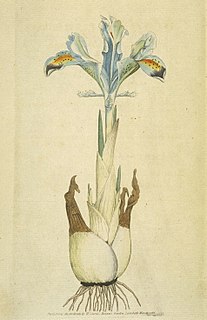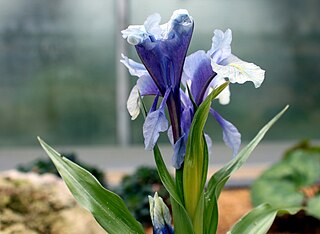
Iris subg. Scorpiris, commonly called Juno, is a subgenus of Iris, representing the smooth-bulbed bulbous irises. For a while it was an independent genus Juno Tratt. in some classifications.

Iris kolpakowskiana, or Kolpakowski's iris, is a plant species in the genus Iris, it is classified in the subgenus Hermodactyloides and section Monolepsis. It is a bulbous perennial from Asia.

Iris histrio, the Syrian iris, is a species in the genus Iris, it is classified in the subgenus Hermodactyloides and section Reticulatae. It is a bulbous perennial from Central Asia: Kyrgyzstan, Israel, Lebanon, Syria and southern Turkey.

Iris tingitana is a species in the genus Iris in the subgenus of Xiphium.

Iris caucasica is a species of plant in the genus Iris, it is also in the subgenus of Scorpiris. Pronounced as 'kaw-KAS-ee-kuh'.

Iris cycloglossa is a species in the genus Iris, in the subgenus Scorpiris. It comes from Afghanistan.
Iris vicaria is a species in the genus Iris, it is also in the subgenus Scorpiris. It is a bulbous perennial from Asia, found in Tajikistan, Turkmenistan and Uzbekistan. It has tall arching leaves, and has varied coloured flowers, with white, blue and purple between April and May.
Iris zaprjagajevii is a species in the genus Iris, it is also in the subgenus Scorpiris. It is a bulbous perennial from Central Asia. It has greyish-green leaves, short stem and white flowers with a yellow crest.
Iris willmottiana is a species in the genus Iris, in the subgenus Scorpiris. It is a bulbous perennial, from Uzbekistan in central Asia. It has green broad leaves, short stems, large flowers in various shades of blue.
Iris orchioides, the 'orchid iris,' is a plant species in the genus Iris, it is also in the subgenus Scorpiris. It is a bulbous perennial, from the mountains of Uzbekistan and Kyrgyzstan. It has dark green leaves, slender stems, up to 3 yellow flowers in spring. It is cultivated as an ornamental plant in temperate regions.
Iris narbutii is a species of flowering plant in the genus Iris, subgenus Scorpiris. It is a bulbous perennial from Central Asia. It has dark green leaves, short stems, spring flowers in shades of greenish-yellow to pale violet.
Iris kuschakewiczii is a species in the genus Iris, it is also in the subgenus Scorpiris. It is a bulbous perennial, from the hills of Kazakhstan. It has dark green glaucous leaves, a short, thick stem, spring flowers in shades of purple.

Iris stenophylla is a species in the genus Iris, it is also in the subgenus Scorpiris. It is a bulbous perennial.

Iris tubergeniana is a species in the genus Iris, it is also in the subgenus Scorpiris. It is a bulbous perennial from Central Asia, in the former states of USSR. It has pale green, pointed or sickle shaped leaves, short flowering stem holding 1-3 spring flowers in shades of yellow.
Iris falcifolia is a plant species in the genus Iris, it is also in the subgenus Iris and in the section Hexapogon. It is a rhizomatous perennial, from Uzbekistan, Kazakhstan, Afghanistan, Iran and Pakistan. It is a small plant, with sickle-shaped greyish-green leaves, lilac-violet flowers and darker veining, and a white or yellow beard. It is cultivated as an ornamental plant in dry, temperate regions.
Iris darwasica is a plant species in the genus Iris, it is also in the subgenus Iris and in the section Regelia. It is a rhizomatous perennial, from Tajikistan and northern Afghanistan. It has long and thin glaucous to grey-green leaves, slender stem and greenish cream or greenish yellow, to dark purple or lilac flowers.

Iris hoogiana is a plant species in the genus Iris, it is also in the subgenus Iris and in the section Regelia. It is a rhizomatous perennial, from the grassy mountainsides of Turkestan. It has long green leaves, which are slightly purple at the base, and a long slender flowering stem. The flowers are blue, ranging from sky-blue to lavender blue and blue purple. It has orange or yellow beards. It is cultivated as an ornamental plant in temperate regions.

Iris korolkowii is a plant species in the genus Iris, it is also in the subgenus Iris and in the section Regelia. It is a rhizomatous perennial, from the mountains of Tien Shan, Pamir and Altai, in Afghanistan and Turkestan. It is commonly known as the Redvein Iris. It has long, sword-shaped grey-green leaves, slender stem, and 2 to 3 white, cream, pale green or light purple flowers which are veined with maroon, chocolate brown or dark purple. It is cultivated as an ornamental plant in temperate regions.
Iris lineata is a plant species in the genus Iris, it is also in the subgenus Iris, and in the section Regelia. It is a rhizomatous perennial, from the mountains of Turkestan, between Tajikistan and Afghanistan. It has tall slender stems, long leaves and greenish yellow flowers covered, with brown violet, or brown purple veining over the top. It is cultivated as an ornamental plant in temperate regions.
Iris goniocarpa is a plant species in the genus Iris, it is also in the subgenus of Iris and in the section Pseudoregelia. It is a rhizomatous perennial, from China, India, Burma and Bhutan. It has yellow green to dark green, long leaves, slender stem and, one flower between blue, lavender-blue, lilac, blue-violet or blue-purple. It is cultivated as an ornamental plant in temperate regions.










